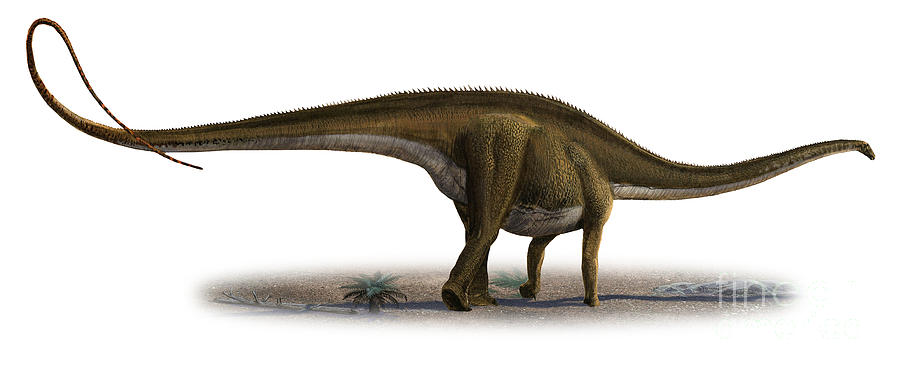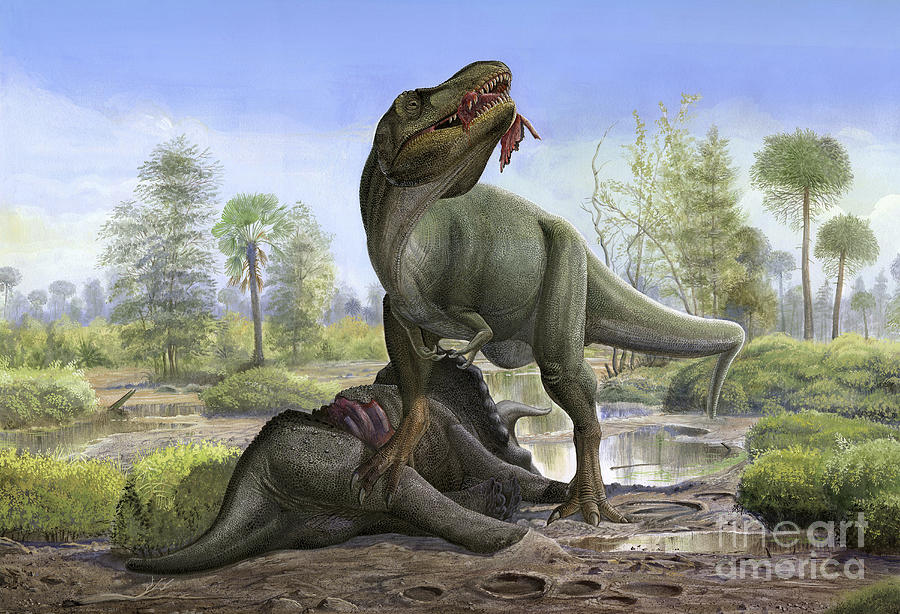Post by Carcharadontosaurus on Nov 13, 2013 21:53:40 GMT -5
Diplodocus carnegii
Diplodocus is a genus of diplodocid sauropod dinosaur whose fossils were first discovered in 1877 by S. W. Williston. The generic name, coined by Othniel Charles Marsh in 1878, is a Neo-Latin term derived from Greek διπλόος (diploos) "double" and δοκός (dokos) "beam", in reference to its double-beamed chevron bones located in the underside of the tail. These bones were initially believed to be unique to Diplodocus; however, they have since then been discovered in other members of the diplodocid family and in non-diplodocid sauropods such as Mamenchisaurus. It lived in what is now western North America at the end of the Jurassic Period. Diplodocus is one of the more common dinosaur fossils found in the Upper Morrison Formation, a sequence of shallow marine and alluvial sediments deposited about 155 to 148 million years ago, in what is now termed the Kimmeridgian and Tithonian stages (Diplodocus itself ranged from about 154 to 150 million years ago). The Morrison Formation records an environment and time dominated by gigantic sauropod dinosaurs such as Camarasaurus, Barosaurus, Apatosaurus and Brachiosaurus. Diplodocus is among the most easily identifiable dinosaurs, with its classic dinosaur shape, long neck and tail and four sturdy legs. For many years, it was the longest dinosaur known. Its great size may have been a deterrent to the predators Allosaurus and Ceratosaurus: their remains have been found in the same strata, which suggests they coexisted with Diplodocus. Modern mass estimates for Diplodocus (exclusive of D. hallorum) have tended to be in the 10 to 16 tonne (11–17.6 ton) range: 10 tonnes (11 tons); 11.5 tonnes (12.7 tons); 12.7 tonnes (14 tons); and 16 tonnes (17.6 tons).

Tyrannosaurus rex
Tyrannosaurus is a genus of coelurosaurian theropod dinosaur. The species Tyrannosaurus rex (rex meaning "king" in Latin), commonly abbreviated to T. rex, is a fixture in popular culture. It lived throughout what is now western North America, with a much wider range than other tyrannosaurids. Fossils are found in a variety of rock formations dating to the Maastrichtian age of the upper Cretaceous Period, 67 to 65.5 million years ago. It was among the last non-avian dinosaurs to exist before the Cretaceous–Paleogene extinction event. Like other tyrannosaurids, Tyrannosaurus was a bipedal carnivore with a massive skull balanced by a long, heavy tail. Relative to the large and powerful hindlimbs, Tyrannosaurus forelimbs were small, though unusually powerful for their size, and bore two clawed digits. Although other theropods rivaled or exceeded Tyrannosaurus rex in size, it was the largest known tyrannosaurid and one of the largest known land predators. By far the largest carnivore in its environment, Tyrannosaurus rex may have been an apex predator, preying upon hadrosaurs and ceratopsians, although some experts have suggested it was primarily a scavenger. The debate over Tyrannosaurus as apex predator or scavenger is among the longest running in paleontology. Tyrannosaurus rex was one of the largest land carnivores of all time; the largest complete specimen, FMNH PR2081 ("Sue"), measured 12.8 metres (42 ft) long, and was 4.0 metres (13.1 ft) tall at the hips. Mass estimates have varied widely over the years, from more than 7.2 metric tons (7.9 short tons), to less than 4.5 metric tons (5.0 short tons), with most modern estimates ranging between 5.4 and 6.8 metric tons (6.0 and 7.5 short tons). Packard et al. (2009) tested dinosaur mass estimation procedures on elephants and concluded that dinosaur estimations are flawed and produce over-estimations; thus, the weight of Tyrannosaurus could be much less than usually estimated. Other estimations have concluded that the largest known Tyrannosaurus specimens had a weight exceeding 9 tonnes.

Diplodocus is a genus of diplodocid sauropod dinosaur whose fossils were first discovered in 1877 by S. W. Williston. The generic name, coined by Othniel Charles Marsh in 1878, is a Neo-Latin term derived from Greek διπλόος (diploos) "double" and δοκός (dokos) "beam", in reference to its double-beamed chevron bones located in the underside of the tail. These bones were initially believed to be unique to Diplodocus; however, they have since then been discovered in other members of the diplodocid family and in non-diplodocid sauropods such as Mamenchisaurus. It lived in what is now western North America at the end of the Jurassic Period. Diplodocus is one of the more common dinosaur fossils found in the Upper Morrison Formation, a sequence of shallow marine and alluvial sediments deposited about 155 to 148 million years ago, in what is now termed the Kimmeridgian and Tithonian stages (Diplodocus itself ranged from about 154 to 150 million years ago). The Morrison Formation records an environment and time dominated by gigantic sauropod dinosaurs such as Camarasaurus, Barosaurus, Apatosaurus and Brachiosaurus. Diplodocus is among the most easily identifiable dinosaurs, with its classic dinosaur shape, long neck and tail and four sturdy legs. For many years, it was the longest dinosaur known. Its great size may have been a deterrent to the predators Allosaurus and Ceratosaurus: their remains have been found in the same strata, which suggests they coexisted with Diplodocus. Modern mass estimates for Diplodocus (exclusive of D. hallorum) have tended to be in the 10 to 16 tonne (11–17.6 ton) range: 10 tonnes (11 tons); 11.5 tonnes (12.7 tons); 12.7 tonnes (14 tons); and 16 tonnes (17.6 tons).

Tyrannosaurus rex
Tyrannosaurus is a genus of coelurosaurian theropod dinosaur. The species Tyrannosaurus rex (rex meaning "king" in Latin), commonly abbreviated to T. rex, is a fixture in popular culture. It lived throughout what is now western North America, with a much wider range than other tyrannosaurids. Fossils are found in a variety of rock formations dating to the Maastrichtian age of the upper Cretaceous Period, 67 to 65.5 million years ago. It was among the last non-avian dinosaurs to exist before the Cretaceous–Paleogene extinction event. Like other tyrannosaurids, Tyrannosaurus was a bipedal carnivore with a massive skull balanced by a long, heavy tail. Relative to the large and powerful hindlimbs, Tyrannosaurus forelimbs were small, though unusually powerful for their size, and bore two clawed digits. Although other theropods rivaled or exceeded Tyrannosaurus rex in size, it was the largest known tyrannosaurid and one of the largest known land predators. By far the largest carnivore in its environment, Tyrannosaurus rex may have been an apex predator, preying upon hadrosaurs and ceratopsians, although some experts have suggested it was primarily a scavenger. The debate over Tyrannosaurus as apex predator or scavenger is among the longest running in paleontology. Tyrannosaurus rex was one of the largest land carnivores of all time; the largest complete specimen, FMNH PR2081 ("Sue"), measured 12.8 metres (42 ft) long, and was 4.0 metres (13.1 ft) tall at the hips. Mass estimates have varied widely over the years, from more than 7.2 metric tons (7.9 short tons), to less than 4.5 metric tons (5.0 short tons), with most modern estimates ranging between 5.4 and 6.8 metric tons (6.0 and 7.5 short tons). Packard et al. (2009) tested dinosaur mass estimation procedures on elephants and concluded that dinosaur estimations are flawed and produce over-estimations; thus, the weight of Tyrannosaurus could be much less than usually estimated. Other estimations have concluded that the largest known Tyrannosaurus specimens had a weight exceeding 9 tonnes.





